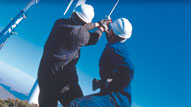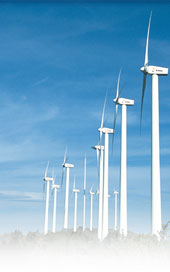1B3 Rotor blades and rotor control
Almost all loads on the components of the wind turbine are derived from the loads at the rotor blades. Therefore it is very important to keep these loads as low as possible and to control them as much as possible.
Modern blade and control technology has its limitations: only the rotor speed, and the pitch angle of the blades can be varied. At present blades are constructed as one single piece, so only the entire span of the blades can be pitch controlled. With the increasing size, a much more detailed control is necessary to alleviate blade loads, to control them at any moment and any position in the rotor plan, and to add aerodynamic damping when necessary. To achieve this, the blades will be equipped with aerodynamic control devices. Airplanes have similar devices: the flaps at the wings.
On the left figure rotor blades with trailing edge flaps are shown. The right figure shows a model rotor blade in the wind tunnel. At the trailing edge, the flaps, activated by piezo-electric material, are clearly visible. Other devices are also being studied. The requirements for the devices incorporated in the rotor blades are very severe.
The technology should be maintenance-free, extremely reliable during a very long time, and low cost.
The specific objectives are to obtain lower loads and to improve stability. The stepping stones towards a full concept, addressed in this project are to:
• establish the potential of embedded control by
aerodynamic/aero elastic analysis;
• specify the requirements of the sensors, actuators and control
equipment, to select the most promising options and verify them by
means of component-prototypes;
• develop and verify design codes (models) for the aerodynamic
& control aspects of composite structures including smart
materials;
• verify the load alleviation and increased stability by wind
tunnel experiments;
• verify the robustness of the construction, by the design and
the construction of a representative part of a blade;
• verify the aerodynamic performance of this blade section by
non-rotating tests in a wind tunnel.
This R&D programme builds on many disciplines. As such, this programme constitutes an integrating, multi-disciplinary approach.
Leaflet

Smart rotor blades and rotor control
Work package leader
• Delft University of Technology (NL)
Work package partners
• Risø National Laboratory - DTU (DK)
• Energy research Centre of the Netherlands - ECN (NL)
• University of Stuttgart (D)
• LM Glasfiber A.S. (DK)
• Fundación Robotiker (E)
• VTT Technical Research Centre of Finland (F)
• Instytut Podstawowych Problemow Techniki -PAN (PL)
• Institute of Physics, Academy of Sciences of the Czech
Republic (CZ)
Contact details
Mr. Gijs van Kuik
Technical University Delft
Delft University of Technolgy, Institute DUWIND
Kluyverweg 1
NL-2629 HS GB Delft
The Netherlands
Tel: +31/15 278 4980
[email protected]

